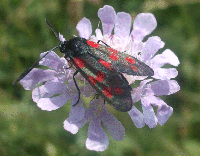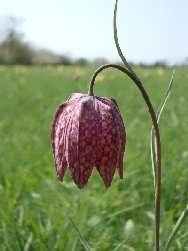When to Watch Wildlife | J | F | M | A | M | J | J | A | S | O | N | D | Search |
Current wildlife highlights | ||
| What's new on this site | ||
| Wildlife calendar | ||
|
Plants and Animals | ||
| Habitats | ||
| Wildlife sites | ||
| WWW links | ||
|
Guide Books | ||
| ||
© PMcS 2006 |
Neutral Meadow Grasslands |
A hay meadow full of wild flowers and buzzing with insects in the heat of high summer, with swallows swooping over the tops of the grass, is many peoples quintessential image of an idyllic countryside scene. However such traditionally managed hay meadows are amongst our most treasured, most sensitive and now rarest wildlife habitats. Such sites are a thing of the past in many counties, but some scattered gems still persist around the country, especially in the Dales. This type of grassland is maintained through a cycle of cutting for hay in mid June to July, followed by grazing by light cattle through winter. The grassland is then left untouched to grow in spring until it is cut once again. In some cases such meadows are in river flood plains, and if they become waterlogged during the winter months can be inaccessible to grazing stock. Without such grazing and cutting this grassland would quickly revert to scrub and then woodland. Much of the diversity of such flower rich grasslands has been destroyed by the use of artificial fertilisers introduced in the 1970s and ploughing. Some have remained where farmers resisted the need for change, or where no one owner had control and hence there was no investment for "improvement". Repeated cutting and grazing allows many flower species to compete with the grass. Also without modern fertilisers the soil has a limited fertility hence reducing the dominance of grasses. In one or two flood plain meadows the rare snake's head fritillary (below) grows in its thousands in spring and provides a truly breath taking sight.
Later cowslips emerge with marsh marigold in the damp ditches. June sees the emergence of ox-eye daisy, meadow buttercup, many grass species, red clover, great burnet, yellow vetch, yellow rattle, meadow rue and black knapweed to name but a few. As hay fever sufferers weep, the rest of us can enjoy a spectacular sea of colour. In some parts of the south of England flood plain grasslands where not traditionally cut but only grazed. These grasslands where also carefully managed to allow river water to run over them in late winter\early spring via an ingenious irrigation channels and hence were saved from frosts . This encouraged the grass to grow particularly early and hence livestock to graze that bit ahead of everywhere else. The long grass in summer is home to many insects, such a six-spot burnet moth, meadow brown and small skipper butterflies and grasshopper species, and birds that feed on them. However some nesting birds, such a corncrakes, require a late hay cut by hand and hence they are no longer found in England, where tractors cut the grass and cut it in July at the latest. |
|
|
All images and text are copyright PMcS 2006

